Review: Carcassonne (iPhone)
Posted by James (admin) on October 5th, 2010
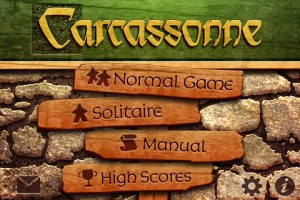 Many serious gamers may feel Carcassonne is too simple for them as it’s a great gateway game; however, I recommend they don’t dismiss Carcassonne on iPhone as it has a lot to offer.
Many serious gamers may feel Carcassonne is too simple for them as it’s a great gateway game; however, I recommend they don’t dismiss Carcassonne on iPhone as it has a lot to offer.
THE GAME
In Carcassonne, players place tiles which show parts of roads, cities and monasteries and place them together to build an entire countryside. On their turn, a player takes and places one tile so that it fits next to any already placed tiles ensuring features like roads continue onto newly placed tiles. After placing a tile, the player has the opportunity to place one of their 7 meeple (mini people) onto the just-placed tile. Placing meeple is the way to score points and a meeple can be placed on a road, in a town, in a field or on a monastery.
The way the meeple scores points depends upon the feature on which they are placed. For example, a meeple on a road scores 1 point for each tile in that road, whereas a meeple in a field scores 3 points for every completed city that their field contains. Apart from meeple in fields, a meeple is returned to the player when the feature they are on is completed, i.e. a city has a complete wall around it and no spaces inside. When all the tiles have been placed, any meeple left on the tiles score points and the player with the highest total wins.
One restriction when placing a meeple is that you can not place a meeple on a feature where another player already has a meeple; however, meeple on separate features can get joined together. If multiple meeple end up together then both players get points (unless one player has more meeple on that feature; in which case, they get all the points).
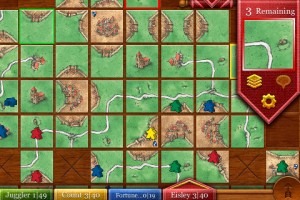 OPINION: GAMEPLAY
OPINION: GAMEPLAY
Carcassonne is a very pretty-looking and very simple game. Each turn a player has a single tile to place and the choice of whether to place a meeple on it or not. This makes the game flow very quickly and is easy to understand. However, there are tactics to be had – balancing grabbing quick points against more risky but greater longer-term gains. Often players try to get more meeple onto high scoring features so they outnumber their opponents and score all the points for themselves. Managing meeple is important too so you don’t end up without meeple when a good point scoring opportunity arises.
In the board game, placing tiles to block other player’s developments is possible, but usually takes the form of just making things difficult unless you know the tile distribution and keeep count of which have already been placed.
OPINION: IMPLEMENTATION
Carcassonne has been released on PC, on Xbox Live and on the Nintendo DS. So, lots of lessons should have been learned by now as to what works and what doesn’t in a digital version. Having played Carcassonne on all of these I think that the iPhone version is the best of them all.
Interface
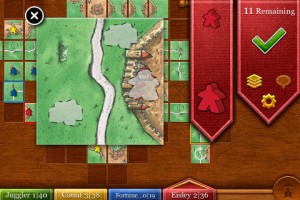 You can zoom in and out of the game board (the tiles already placed) and all the possible locations where your current tile can be placed are highlighted. You tap on a location to move your tile there, and tap it to rotate it. When you’ve placed a tile, you’re shown a large version of it with dotted outlines for all the possible legal meeple placements. Just tap on the desired outline to place a meeple there. When satisfied with your tile and (optional) meeple placement, tap the large green tick to complete your turn.
You can zoom in and out of the game board (the tiles already placed) and all the possible locations where your current tile can be placed are highlighted. You tap on a location to move your tile there, and tap it to rotate it. When you’ve placed a tile, you’re shown a large version of it with dotted outlines for all the possible legal meeple placements. Just tap on the desired outline to place a meeple there. When satisfied with your tile and (optional) meeple placement, tap the large green tick to complete your turn.
When positioning a tile, you can see any locations that will now be impossible to fill because there are no appropriate tiles remaining – this makes blocking much easier to assess and it’s personal preference whether you like that or not. Also, at the bottom of the screen, the interface showing player’s scores and remaining meeple can either be quite large with the player images, or can be reduced to text only. This is great and the developer understands that information leads the visual design.
In all, the interface is really well designed and makes the game very fast and easy to play. Even the score breakdown screen showing from which features you got your points is a nice touch.
Multiple Players & AI
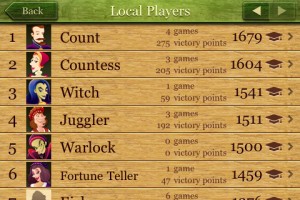 Playing against computer (AI) players is superbly handled. There are several different AI types (easy, strong, weird and evil) to play against and they all take their turns quickly. You and each AI player has an ELO rating – this changes after each game and the amount you gain or lose depends upon the opponents that you beat or lost against. This is a really nice touch as it gives you anon-going goal, plus you can tailor your opponents and the challenge as you play. – start against easier opponents and play against tougher AI when you regularly beat them, or dive straight in against the tough AI to start.
Playing against computer (AI) players is superbly handled. There are several different AI types (easy, strong, weird and evil) to play against and they all take their turns quickly. You and each AI player has an ELO rating – this changes after each game and the amount you gain or lose depends upon the opponents that you beat or lost against. This is a really nice touch as it gives you anon-going goal, plus you can tailor your opponents and the challenge as you play. – start against easier opponents and play against tougher AI when you regularly beat them, or dive straight in against the tough AI to start.
Also, you can play ‘Hot seat’ (one iPhone passed between multiple people) and this can include AI players too.
Online Play
Live online play can be played either against friends who you invite using their email address or you can play against random live opponents also looking for a game at that moment. A player has 90 seconds in which to take their turn and there’s a text chat facility too. Like playing against the AI, a player has separate ELO ratings for both playing against friends as well play against random online opponents.
Solitaire Mode
In solitaire mode, players are challenged not to score points but to build roads and cities of increasing sizes – first a 2-length road, then a 3-length, etc. and the same for cities. The aim is to build a 6-length road and a 6-tile city. Players start with 1000 points and points are deducted each time a tile is placed – the amount deducted is equal to the maximum width plus the maximum height of the currently placed tiles. So, working in a small space is key to getting a good score. The order in which the tiles are dealt to the player is fixed so will be the same every time you play a particular challenge, and there are lots of different challenges. I wasn’t a fan of this mode on my first play as I wanted to score points normally but, when I understood the challenge properly, I really started to like it.
Game Saving
You can save games when you exit them at any time and you can have multiple games saved. Also, the app handles switching to other apps too.
Downsides
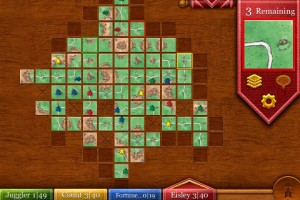 So, what are the downsides? Well, there aren’t many. I would have liked the option to set a few of the scoring rules because there have been a few different ways to score for farms and 2-tile cities over the years. Board gamers will know that loads of expansions have been released for Carcassonne and I’d like to see those as optional items at some point and understand that may cost extra.
So, what are the downsides? Well, there aren’t many. I would have liked the option to set a few of the scoring rules because there have been a few different ways to score for farms and 2-tile cities over the years. Board gamers will know that loads of expansions have been released for Carcassonne and I’d like to see those as optional items at some point and understand that may cost extra.
Fully turn-based online play (i.e. players don’t need to be online at the same time) would have been nice, especially if AI players could be added into a game too. The only thing missing from the fully online play is being able to set how many players you want to play against as the matchmaking service automatically places you in a game and quite often this will be a 2-player game. Personally, I prefer games against multiple opponents so I would happily wait a bit longer to gather enough players, or would like AI players to fill in the gaps.
Conclusion
Carcassonne may be too light for many serious gamers (after all, it is its simplicity that has made it so successful as a board game) and I’m a game player who will probably only play the Carcassonne board game with newer or first-time gamers. However, I’m really enjoying playing Carcassonne again on iPhone because it does contain good gameplay and the iPhone version plays so quickly and smoothly.
James.
[Played against 2, 3 and 4 AI players as well as online]
Want to purchase Carcassonne for iPhone or iPad?
Use a link below to go to the App Store and 4% of your purchase will go towards maintaining this site (at no extra cost to you).
 |
For iPhone (reviewed) |
 |
For iPad |


October 11th, 2010 at 9:49 pm
[…] this link for the review: MetaGames » Blog Archive » Review: Carcassonne (iPhone). Share This entry was posted in Internet Finds. Bookmark the permalink. ← Windows […]